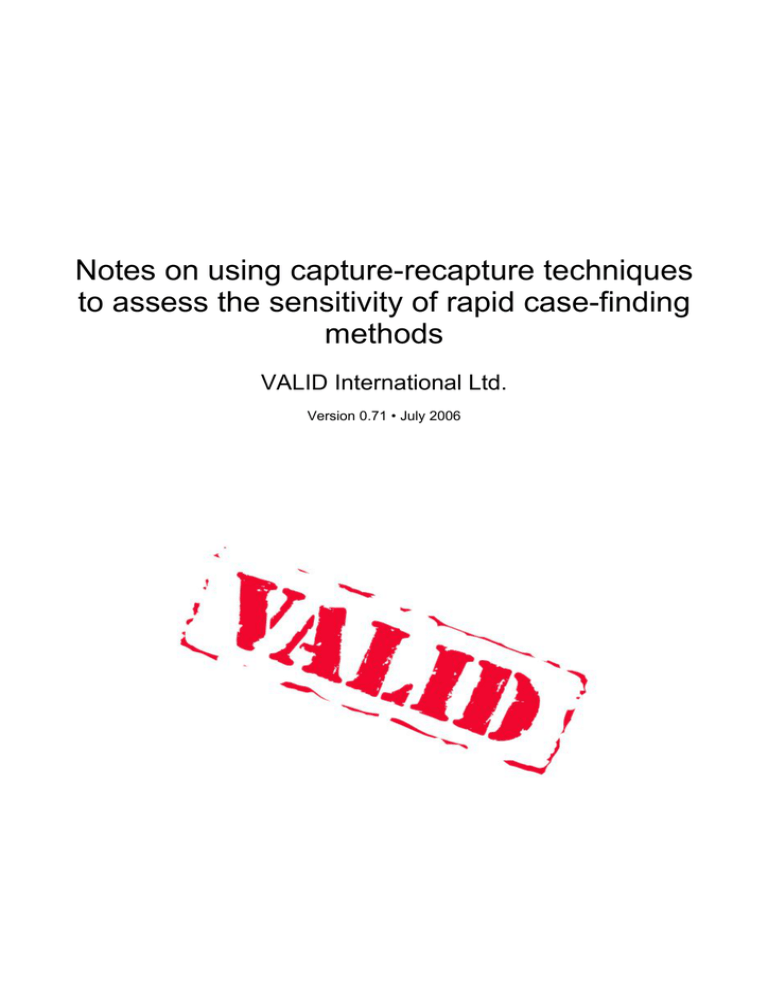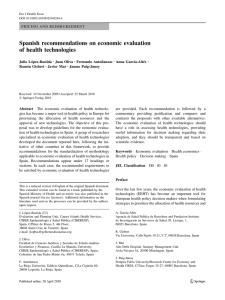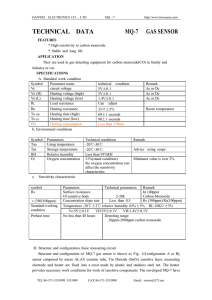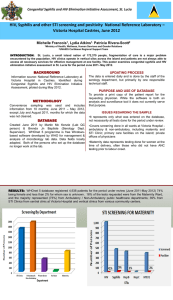Notes on capture-recapture techniques
Anuncio

Notes on using capture-recapture techniques to assess the sensitivity of rapid case-finding methods VALID International Ltd. Version 0.71 • July 2006 Capture-recapture studies Capture-recapture studies are used to estimate the size of a population when a census may be infeasible or impossible to conduct. The basic idea of capture-recapture studies is to sample and identify individuals, or cases, from a population and then resample the population to see what fraction of individuals, or cases, in the second sample were identified in the first sample (i.e. the fraction of individuals, or cases, that were found in both samples). In this document we will explore the use of capture-recapture techniques to estimate the sensitivity (also called exhaustivity) of two case-finding methods. The sensitivity of a case-finding method is a measure of how well the method performs at finding cases. This is useful for: 1. Selecting a rapid case-finding method for use by outreach workers. 2. Selecting a rapid case-finding method for use in coverage surveys using the centric systematic area sampling (CSAS) method or related methods. In both cases we would want a rapid case-finding method that finds all or nearly all cases (i.e. a rapid casefinding method with a high sensitivity). This document focuses on severe acute undernutrition but the methods outlined may be applied to moderate acute undernutrition and also to non-nutritional conditions. Figure 1 shows a capture-recapture study in diagram form. In this diagram: N = Total number of cases in the study population. M = Number of cases found in the first sample. C = Number of cases found in the second sample. R = Number of cases found in both samples. For this application, one sample will usually be collected using a census (or census-like) sampling method such as central-location screening or house-to-house screening and the other sample will be collected using a rapid case-finding method. Figure 2 presents a capture-recapture study with four sets of cases labelled a, b, c, and x. In this diagram: M =ab C =ac R=a N =abcx Where x, the number of cases not found by either sample, is unknown. This information can be presented as a two-by-two table (Figure 3). If we assume: 1. The population is closed (i.e. there is no change in the population during the investigation). 2. Cases sampled on both occasions can be identified and matched. 3. Each case has an equal chance of being included in each sample (equal catchability). 4. The presence of a case in the second sample is not influenced by the presence of the same case in the first sample (independence). then we can calculate a value for the unknown x cell in the table. Under these assumptions (and particularly the assumption of independence) the probability of a case being present in the second sample if it is present in the first sample: P in sample 2 | in sample 1= a ab and the probability of a case being present in the second sample if it is not present in the first sample: P in sample 2 | in sample 1= c cx are the same: a c = ab cx This formula can be re-arranged to find x: a c = ab cx c×ab=a×c x b×c=a×x x= b×c a Knowing x allows us to estimate the total number of cases in the study population: N =abcx N =abc N= b×c a ab×ac a This can be expressed more simply as: N= M ×C R This formula can overestimate the total number of cases in the study population when used with small sample sizes and the following formula: N= M 1C 1 −1 R1 is preferred. This formula is commonly implemented in software that can work with data from capturerecapture studies (e.g. the EpiTable module in EpiInfo). This formula should always be used in preference to the simpler formula. Since it is impossible to have part of a case, the estimate of N should be rounded to the nearest whole number. If the fractional part is 0.5 then rounding up (e.g. from 19.5 to 20) is preferred for this application. Estimating case-finding sensitivity using capture-recapture study data Once we have an estimate of the total number of cases in the study population we can estimate the sensitivity of the case-finding methods used for each sample: Sensitivity of method one %= ab M ×100= ×100 N N Sensitivity of method two%= ac C ×100= ×100 N N Confidence intervals can be calculated for these estimates. The details of the calculations required are beyond the scope of this document. The required calculations can be performed using the EpiTable module in EpiInfo. We are usually only interested in the sensitivity of the rapid case-finding method. More specifically, we are interested in confirming that the sensitivity of the rapid case-finding method is 100% (i.e. all cases found) or nearly 100% (i.e. nearly all cases found). See the sections Estimating case-finding sensitivity and Case-finding sensitivity and coverage estimates (below) for guidance on interpreting sensitivity estimates from capture-recapture study data and acceptable levels of case-finding sensitivity for use in coverage surveys using the centric systematic area sampling (CSAS) method or related methods. Underlying assumptions It is important that the assumptions behind the estimate of the total number of cases in the study population are not violated. If the closed population assumption is violated then cases found in one sample cannot be found in the other sample. This reduces the probability of recapture and will lead to an overestimation of N and an underestimation of sensitivity. Our experience using capture-recapture techniques in CSAS coverage surveys suggests that this assumption can be met provided that only a short time is allowed between the collection of the two samples so that cases are not lost from the study population due to mortality, recovery, or displacement and cases do not enter the study population either as new cases or as existing cases arriving from outside of the study area. It is also important to ensure that neither sample is taken on market days, feast days, holidays, distribution days, or days / times when many people may be absent from their home community. In one study we found that people from neighbouring villages were attracted by central-location screening activities. This meant that the population for central-location screening was larger than the population for rapid case-finding. This was likely to lead to an overestimation of N and an underestimation of the sensitivity of the rapid case-finding method. In the same study, a study village was located close to a major road and passers-by attempted to join the central-location screening. Again, this meant that the population for central-location screening was larger than the population for rapid case-finding. This was likely to lead to an overestimation of N and an underestimation of the sensitivity of the rapid case-finding method. In such situations it is important to identify and censor “excess” members of the study population by asking the carers of children where they live and confirming this with a key informant or local guide such as a village health worker, traditional birth attendant, or traditional healer. In one study, community leaders recognised such “outsiders” and, after explaining the purpose of the screening exercise, asked them to leave. Such problems may also be avoided by careful selection of study sites. In both cases central-location screening acted as an attractor and the use of alternative methods such as house-to-house screening should be contemplated. Ensuring a closed population can be very difficult in refugee camps during the early stages of on an emergency. This is because the camp population may change on a daily basis as refugees arrive or are dispersed to other camps or to live within the host-population. The problem still exists once a camp population has stabilised as the population that can be feasibly sampled may change from day-to-day as carers attend activities such as education / health-promotion / vaccination programs and food or clothing distributions. In these situations it is important to work closely with camp authorities to identify if a violation of the closed population assumption is likely, and to become familiar with activity timetables to ensure that you take both samples when carers are likely to be at home with their children. Camps for internally displaced persons (IDPs) are even more challenging than refugee camps since IDP camps tend to be less organised than refugee camps and it can be very difficult to track population changes and IDPs may leave the camp for work or foraging activities on an irregular basis. In such situations you will probably be restricted to identifying whether or not a violation is likely to have occurred and use this information when interpreting sensitivity estimates. Care should be taken when sampling to ensure that the physical boundaries of areas to be sampled are well defined. Failure to do so is likely to results in different areas being used for the two samples. Since mistakes will be made at the boundaries of sampling areas this can have a large effect on the size of the population sampled on each occasion. This may be a particular problem in urban areas. In such situations it is a good idea to use existing boundaries such as roads and have the study team to produce a rough map of the area used for the first sample which can be used when collecting the second sample. In some situations you may find direct evidence of a violation of the closed population assumption and be able to correct for this during data-collection. In one study we were, during the recapture phase, directed to a household and were informed by the grandmother that the mother had taken the child to another village. The grandmother was able to provide matching information and the child could be matched with a case found in the capture phase of the study. In this case the child was treated as a recaptured case. In another study we were directed to a household in which the identified child had died between the capture and recapture phases of the study. In this case, the child was matched and treated as a recaptured case. Cases found in both samples must be reliably identified and matched. If true matches are missed then the number of recaptured cases is falsely reduced leading to an overestimation of N and an underestimation of sensitivity. If false matches are created then the number of recaptured cases is falsely increased leading to an underestimation of N and an overestimation of sensitivity. In our experience, matching has not proved to be a problem provided sufficient identifying information is collected. The minimum identifying information required is full name (i.e. first, middle, and last names), sex, and age. The equal catchability assumption does not require that the probability of being found is the same for both methods. It requires that all cases have an equal chance of being found for each method. If some cases have a low probability of being found by either method then N will be underestimated and sensitivity overestimated. In our experience, carers of very sick children (i.e. children likely to be cases) tend to be reluctant to attend central-location screening particularly if simultaneous screening of several communities at a central point (leading to children being screened outside of their home community) is used. This is unlikely to be a major problem since such children tend to be found by a reasonably sensitive active casefinding method. The use of alternatives to central-location screening such as house-to-house screening should be contemplated should you have any doubts about the ability of the rapid case-finding method to find very sick children. You should be aware, however, that sick children may also be “hidden” in house-tohouse screening. It is vital to have a good understanding of how the local population defines sickness and malnutrition in order to develop a sensitive rapid case-finding method. In one study we found a marked reluctance in the population to attend for central-location screening and to co-operate with screening activities using a rapid case-finding method. This was found to be due to screening fatigue caused by the villages being repeatedly screened without any obvious and direct advantage to the community or to the screened individuals. This is likely to be a problem when villages are selected because of their proximity to feeding centres and main roads. Such problems may be avoided by careful selection of study sites. Screening fatigue may also be introduced by the capture-recapture study itself and this may negatively effect casefinding sensitivity during a subsequent coverage survey. For this reason it is recommended that villages close to but outside of the area of any planned coverage survey be used for the capture-recapture study. The assumption of independence (i.e. that the presence of a case in the second sample is not influenced by the presence of the same case in the first sample) underlies the derivation of the estimator for N. If there is positive dependence (i.e. if cases found in the first sample are more likely than cases not found in the first sample to be found in the second sample) then N will be underestimated and sensitivity overestimated. If there is negative dependence (i.e. if cases found in the first sample are less likely than cases not found in the first sample to be found in the second sample) then N will be overestimated and sensitivity underestimated. The assumption of independence is violated in almost all capture-recapture studies but efforts should be made to minimise the bias that this may introduce. For testing case-finding procedures for use in CSAS coverage surveys we have used separate teams assisted by different key informants to take the two samples (i.e. the same team never took both samples from a particular village) so as to avoid introducing positive dependence and issued referral slips only after the second sample has been taken so as to avoid introducing negative dependence. From the foregoing it should be clear that capture-recapture studies should be undertaken with considerable care so as to avoid gross violations of the assumptions behind the method. Most capture-recapture studies will violate the underlying assumptions to some degree but can still provide useful results because we can usually identify the violation and predict its likely effect on the estimate of case-finding sensitivity (Table 1). The assumptions behind the capture-recapture method and measures to avoid their gross violations should inform the planning and execution of capture-recapture studies (Table 1). Sample sizes for capture-recapture studies Sample size calculation is more complicated for capture-recapture studies than it is for (e.g.) cross-sectional prevalence studies since there are three sample sizes (i.e. M, C, and R) to consider. Sample size calculations are informed by the fact that the formula: N= M 1C 1 −1 R1 is an unbiased estimator provided: M C N and: R7 The estimate of the total number of cases in the study population is unbiased if these constraints are met. Working with these constraints requires estimates of the case-finding sensitivity of both methods and an estimate of the total number of cases in a population. These estimates need only be rough guesses. Suitable guesses for case-finding sensitivity are: Central location screening : 50% 60% House-to-house screening : 90% 100% Active case-finding : 75% 85% It is best to use a high guess for the total number of cases in a population. This should be informed by the prevalence of the condition (e.g. from a recent nutritional anthropometry survey) and the size of the study population adjusted to take into account program eligibility criteria: N =Population×Proportion of Population Elligible for Intervention×Prevalence Census data should be used when available but it is usually safe to assume that 20% of the total population is aged between 6 and 59 months. Example 1 shows how to apply the sample size constraints when planning a capture-recapture study. It is also possible to apply sample size constraints retrospectively to check whether they were met (Example 2). If the sample size constraints are not met then the size of the study population should be increased. In some situations this may not be possible (e.g. due to cost or time constraints in very low prevalence situations). Just as with the assumptions underlying the the capture-recapture method, results from studies that do not meet the sample size constraints can still be useful. Failure to meet the sample size constraints will lead to an overestimation of N and an underestimation of sensitivity although the effect is likely to be small in low prevalence situations. Estimating case-finding sensitivity Case-finding sensitivity is estimated by dividing the number of cases found using the case-finding procedure under test by the estimate the total number of cases in the study population found by the capture-recapture method. If the case-finding procedure being tested was used for the first sample then: Sensitivity %= M ×100 N If the case-finding procedure being tested was used for the second sample then: Sensitivity %= C ×100 N This procedure is illustrated in Example 3. The conduct of the capture-recapture study should always be evaluated to check if any of the assumptions underlying the capture-recapture method have been violated. Most capture-recapture studies will violate the underlying assumptions to some degree but can still provide useful results because we can usually identify the violation and predict its likely effect on the estimate of case-finding sensitivity (Table 1). It is usually possible to identify the direction but not the magnitude of any bias that may have been introduced by violations of the underlying assumptions. Any violations and their likely effect on the estimate of casefinding sensitivity should be documented in study or coverage survey reports and the estimate of casefinding sensitivity qualified by phrases such as “at most x%” or “at least x%” (see Example 3). Case-finding sensitivity and coverage estimates The CSAS coverage survey method (and similar methods) relies on using a case-finding method with high sensitivity. Ideally this should be 100%. With careful design and testing it is often possible to achieve a case-finding sensitivity of 100% particularly for severe acute undernutrition. A case-finding sensitivity of below 100% found by a capture-recapture study could be due to violations of the assumptions behind the capture-recapture method or to failure to meet the sample size constraints. It may also be due to a poorly designed or applied case-finding procedure or to the fact that you are working with a difficult population (an example of a difficult population is one in which people do not know their neighbours such as the population of a recently established IDP camp). In such situations you should evaluate whether the capturerecapture assumptions were violated and whether the sample size constraints were met and take this into account when assessing case-finding sensitivity (see Table 1). You should also seriously consider whether the case-finding procedure is well designed and was properly applied during the capture-recapture study. If you have any doubts regarding the case-finding procedure then you should either redesign the procedure and test it again using a new capture-recapture study or consider whether to adopt a house-to-house census sampling approach which will usually have close to 100% sensitivity. You should certainly consider doing this if the case-finding sensitivity is below about 75% after taking into account the likely effects of violations of the capture-recapture assumptions or failures to meet the sample size constraints. It is possible, but not recommended, to proceed with a coverage survey using a low sensitivity case-finding method. Doing so will produce a biased survey result. The nature of the bias will depend upon the nature of the underlying faults in the case-finding procedure but the most likely effect will be to exclude cases that are difficult to find. Surveys using a low sensitivity case-finding procedure will be restricted to assessing coverage in easy to find cases. Since such cases are likely to have been found and recruited by the program this may cause the survey to overestimate program coverage. This likely bias should be noted in survey reports. Using a case-finding procedure with a sensitivity of between 75% and 100% is reasonable because such a method is likely to exclude only the most difficult to find and recruit cases which are unlikely to be covered by any program. Case-finding sensitivity and coverage estimates for two or more programs It is important to avoid confusion regarding case-definitions when developing case-finding procedures and estimating their sensitivities for use in coverage surveys that estimate the coverage of two or more related programs with differing case-definitions. For example, a coverage survey may need to estimate the coverage of an outpatient therapeutic care program (OTP) and an associated supplementary feeding program (SFP). These programs will have different program entry-criteria (case-definitions). For example: Example entry-criteria for OTP and SFP programs Program Case-definition / program entry-criteria OTP MUAC < 110 mm or bilateral pitting oedema SFP MUAC between 110 mm and 124 mm (inclusive) or recent discharge from OTP In these situation you should estimate sensitivity separately for each case-definition using a capturerecapture study with a sample size calculated for the less common (more severe) condition. When you do this you will probably find that the case-finding method is 100% sensitive for the more severe condition but is considerably less than 100% sensitive for the less severe condition (typically, it will be between 60% and 80%). It is usually OK to proceed with a case-finding sensitivity of between 60% and 80% for the less severe condition because case-finding sensitivity is likely to be satisfactory for the more severe cases. For example: Example case-finding sensitivities and severity of wasting Program OTP SFP MUAC Sensitivity < 110 mm 100% Between 110 mm and 115 mm (inclusive) 100% Between 116 mm and 120 mm (inclusive) 80% Between 121 mm and 124 mm (inclusive) 65% Estimating prevalence from a CSAS coverage survey Prevalence can be estimated indirectly from coverage survey data using the formula: p= n 1 × ×100 POP S where: p = Prevalence estimate n = Number of cases found in the coverage survey POP = Population of communities sampled in the coverage survey S = Estimate of case-finding sensitivity The population of communities sampled in the coverage survey should be adjusted to take into account program eligibility criteria: POP=Population×Proportion of Population Elligible for Intervention Census data should be used when available but it is usually safe to assume that 20% of the total population is aged between 6 and 59 months. If you have a confidence interval for the sensitivity of the case-finding method you can also calculate a confidence interval on the prevalence estimate using the following formulae: p LCL = n 1 × ×100 POP S UCL pUCL = n 1 × ×100 POP S LCL where: pLCL = Lower confidence limit for prevalence estimate pUCL = Upper confidence limit for prevalence estimate n = Number of cases found in the coverage survey POP = Population of communities sampled in the coverage survey SLCL = Lower confidence limit for the estimate of case-finding sensitivity SLCL = Upper confidence limit for the estimate of case-finding sensitivity Example 4 illustrates how to apply these formulae to coverage survey data. This method of estimating prevalence is sensitive to errors in the denominator (N). Where possible, census data should be used and corrected for population growth (and other population changes such as mortality, migration, and displacement). If census data is not available then roof counts can be used. This will require a small survey to estimate mean household size. Community populations can then be estimated as the number of roofs in the sampled community multiplied by mean household size. Local leaders may be able to provide accurate population figures in some situations. Figure 1 : A capture-recapture study N M C R Figure 2 : The four sets of cases in a capture-recapture study N M b C a R x c Figure 3 : The four sets of cases in a capture-recapture study presented as a two-by-two table Case found in sample 2? Case found in sample 1? Yes No Yes a b No c x From Figure 2: M C R N = = = = a + b a + c a a + b + c + x Table 1 : Assumptions, violations, effects, and preventatives Violated assumption Effect on ... N Sensitivity Preventive measures Short time between samples. Avoid sampling on certain (e.g. market) days. Careful selection of study sites. Appropriate use of central-location screening. Testing for residency. Closed population Clearly define the physical boundary of each study site: Existing boundaries. Map study area for first sample. Ensure that local guides understand the scope of the study population and do not introduce bias by systematic exclusion of some individuals. Use community leaders and key informants to identify and exclude “outsiders” from inclusion in the study. True matched missed Reliable matching Collect sufficient identifying data. False matches created Equal catchability Use a method sensitive to very sick children. This may require qualitative work to understand how the local population defines sickness and malnutrition. Use house-to-house screening for one sample. Careful selection of study sites. Use separate teams to collect each sample. Positive dependence Negative dependence Refer cases to service after second sample. Increase size of study population (if possible). Use different informants / local guides for each sample. Independence Inadequate sample size Example 1 : Applying sample size constraints during study planning A capture-recapture study is planned to take place in eight communities with an estimated total population of 4680. The prevalence of severe acute undernutrition is estimated to be around 2%. Census data indicates that 19% of the population are aged between 6 and 59 months. The total number of cases in the study population will be approximately: N =4680× 19 2 × =18 100 100 Since it is impossible to have part of a case, the estimate of N has been rounded to the nearest whole number. If we estimate that the sensitivity of the first case finding method (central-location screening) will be 55% then the number of cases found by that method (M) will be: M =18× 55 =10 100 Since it is impossible to have part of a case, the estimate of M has been rounded to the nearest whole number. If we estimate that the sensitivity of the active case-finding method will be 80% then the number of cases found by that method (C) will be: C =18× 80 =14 100 Since it is impossible to have part of a case, the estimate of C has been rounded to the nearest whole number. In this example M + C would be: M C =1014=24 R would be: R= M ×C 10×14 = =8 N 18 Since it is impossible to have part of a case, the estimate of R has been rounded to the nearest whole number. The sample size constraints: M C N and: R7 are likely to be met in the planned study. Example 2 : Applying sample size constraints retrospectively A capture-recapture study found: Cases found by central-location screening (M) : 6 Cases found by active case-finding (C) : 8 Cases found in both methods (R) : 5 The total number of cases in the study population is estimated to be: N= M 1C 1 −1 R1 N= 7×9 −1=10 6 Since it is impossible to have part of a case and the fractional part of the calculated value for N is 0.5, the estimate of N has been rounded up to the nearest whole number. This study did meet the rule-of-thumb: M C N since: 68=14 which is larger than the estimate for N (10). The study failed to meet the constraint: R7 since: R=5 Example 3 : Assessing case-finding sensitivity A capture-recapture study found: Cases found by central screening (M) : 30 Cases found by active case-finding (C) : 43 Cases found in both methods (R) 22 : The total number of cases in the study population is estimated to be: N= M 1C 1 −1 R1 N= 31×44 −1=58 23 Since it is impossible to have part of a case, the estimate of N has been rounded to the nearest whole number. The sensitivity of the active case-finding method is: Sensitivity %= Sensitivity %= C ×100 N 43 ×100=74 % 58 During the survey there was some concern that the closed population assumption had been violated due to people from neighbouring villages being attracted by central-location screening activities. This is likely to have led to to an overestimation of N and an underestimation of sensitivity. The case-finding sensitivity is, therefore likely to be somewhat higher than the calculated estimate. This could be documented in the study report as “at least 74%”. The sensitivity of the tested case-finding method is, therefore, likely to be above about 75% and the tested case-finding method may be used in a coverage survey. Example 4 : Estimating prevalence from a CSAS coverage survey A CSAS coverage survey found 195 cases of severe acute undernutrition. A capture-recapture study undertaken immediately prior to the coverage survey estimated the sensitivity of the active case-finding method used to be 74%. The 95% confidence interval for the case-finding sensitivity was 65% 87%. The total populations of the communities sampled in the coverage survey was 461,278. Census data indicated that 21.7% of the total population were aged between 6 and 59 months. The eligible populations was: POP=Population×Proportion of Population Elligible for Intervention POP=461278× 21.7 =100097 100 The prevalence of severe acute undernutrition was estimated as: p= n 1 195 1 × ×100= × ×100=0.26 % POP S 100097 74/100 The lower 95% confidence limit on the prevalence estimate was: p LCL = n 1 195 1 × ×100= × ×100=0.22 % POP S UCL 100097 87/100 The lower 95% confidence limit on the prevalence estimate was: pUCL = n 1 195 1 × ×100= × ×100=0.30 % POP S LCL 100097 65/100




